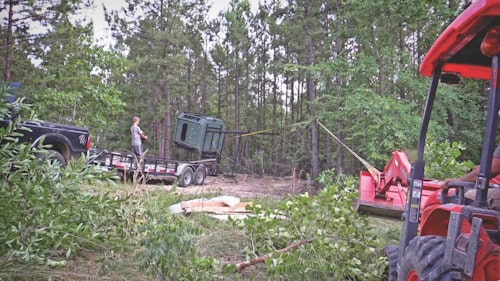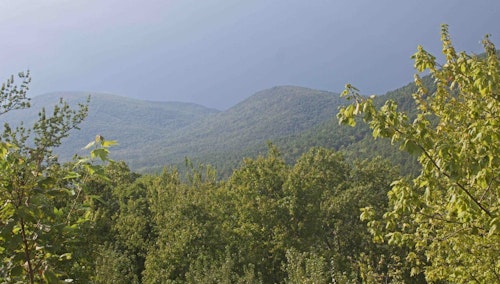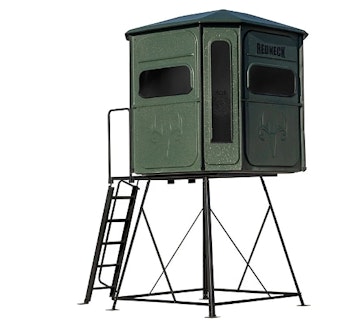The October sun dipped below the last ridge of western skyline, creating an ominously lit scene. In ghost-like fashion, a giant black mass came my way, the movements appeared deliberate, yet shadow-like. Finally, I recognized the black mass, tip-toeing down a fallen log like a ballerina. “It’s Batman,” I whispered under my breath.
After capturing the first trail camera picture of the giant bear in 2014, a legend was born. I’d hunted this property in Oklahoma for five years and had never seen the enormous bear firsthand, until now. His curled ears and jet-black fur made him look like an overweight Sasquatch in a Batman costume.
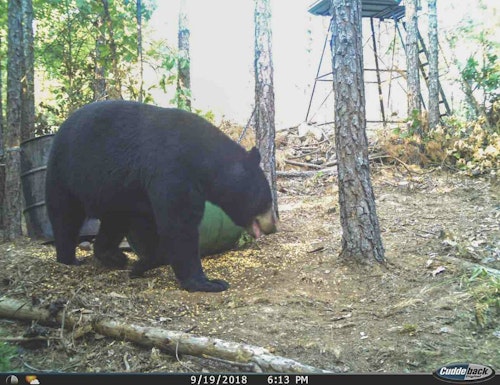
Before you get any ideas that targeting older mature males over bait is easy, I’ll head you off at the pass. Having hunted bears all over North America utilizing different methods, a do-it-yourself hunt over bait takes as much, or even more work and calculation than any other hunt I’ve tried. Hunters in this part of the country that consistently take mature males over bait do a lot of things right, and little is left to chance. Hard work and meticulous execution of the plan is critical when hunting giant black bears, maybe more than any other animal I’ve hunted. Big bears are shifty, like shadows.
Older bears learn the game of baiting quickly. New hunters can be fooled by the naivety of younger animals that throw caution to the wind around bait sites, coming in daylight or even coming in knowing a human is present. Just like big whitetails, big bears are extremely good at avoiding humans. However, they aren’t prey animals so they don’t have the same flight response as an ungulate, which can be confusing to new bear hunters. Bears are quirky, and they learn human behavior quicker than humans learn bear behavior.
Here’s a scenario to consider: A new hunter walks in to a bait site, leaves bait and then walks out. A bear wind checks the bait to make sure the hunter is gone and then comes in to eat. However, on opening day, the hunter doesn’t freshen the bait, instead he stays and hunts. A big bear recognizes the difference and doesn’t come in until after dark. Finally, after repeating the latter step several times, the new hunter believes he’s hunting not only a ghost, but the ghost’s shadow. The only way to beat the bear is to beat its nose, and that’s extremely difficult.
In complete honesty, I have never found a way to beat a bear’s nose 100 percent of the time. I’d like to report scent killer products, ozone and playing the wind work, but they haven’t for me. Go ahead and call me a dream crusher. In Oklahoma, typical October temperatures are warm, pushing into the upper 80s with high humidity. Just getting out of your truck you’ll break a sweat. The shower you took in your scent free soap isn’t going help you at this point. I’ve used ozone products for many years and the constant swirling winds of these mountains nullify its effectiveness elsewhere.
Scent free clothing is nice, except a bear isn’t concerned about your clean clothes, he’s worried about the smelly human wearing them. Stand placement on the downwind side of the bait sounds good in theory, but the big bears come in from wherever is most advantageous. Being limited to baiting on private land, and often small tracts, you won’t always have the liberty to utilize terrain features to avoid his nose.
When a big bear is pounding a bait consistently, he’s likely to bed close enough to monitor it 24 hours a day. I’m not trying to be a non-conformist or make a super hero of big bears, I’m just being 100 percent honest regarding my experiences with scent control and bears. In a few places — the Canadian wilderness — scent control measures don’t seem to matter at all, but in most places — where bears perceive humans as their No. 1 threat — controlling scent is the only ticket to the greatest bear show on earth. Luckily, I punched my ticket last fall.
My Silver Bullet
In southeast Oklahoma, four counties are open to bear hunting and you can hunt bears over bait on private land. Typically between 30 and 100 bears are harvested each year from a population of just over 2,000 animals. In early August 2018, I decided to try an enclosed blind I hoped would offer significant scent concealment. I put up a Redneck Buck Palace blind on a property we knew held big bears.
When I talked to the guys at Redneck, they said, “To our knowledge, nobody has used a Redneck blind for the sole purpose of bear hunting.” They aren’t 100 percent scent proof, and if they were you’d suffocate in them, but I’ve found them to be effective at keeping human scent away from animals at close range. The windows and door are sealed by rubber gaskets. The key to the whole trial was going to be keeping the windows and doors closed until moments before the shot. Hunting in high temperatures, I knew that it was going to be hot, but I was willing to do whatever it took.
The combination of the blind and a significant mast failure worked together in concert. When natural mast is plentiful, it’s hard to draw bears away from it. It seems the big bears are the first to leave baits for falling acorns. However, when mast is scarce, bears will pound the baits. In 2018, about three weeks before the season, I began to get daylight pictures of “Batman.” It was exciting, but I’d been let down for the last four years by his nocturnal nature and avoidance of the site when I hunted. I felt like I had all needed elements in place, namely the blind, but he still had to cooperate by visiting the site during the day. Every time I pulled the card from my trail camera, I was encouraged to see him, but knew he could leave any day — or become totally nocturnal. These bears will leave your baits in a heartbeat this time of year, never to return.
As Oct. 1 approached, I bought my $506 out-of-state Oklahoma bear tag, which must be purchased before the season opener. It’s my annual offering to the wildlife conservation efforts of the Sooner State. More than once the Walmart cashier has questioned my sanity. “That’s a lot of money for a bear,” said the sweet old lady as I swiped my debit card. She wouldn’t know it, but I would have probably sold anything I owned to buy that tag. Of all the bear hunting I’ve done across North America, Oklahoma is my favorite place to hunt. Yes, you read that correctly.
Oklahoma Black Bears
A huntable and thriving population of bears in Oklahoma is a testament to the success of the North American Model of Wildlife Conservation. In the 1950s, hunting-minded game and fish officials brought bears into Arkansas after their extirpation around the turn of the 20th century. After nearly 70 years, bears have expanded their range in every direction out of Arkansas including Missouri, Mississippi, Louisiana, Texas and Oklahoma. Large blocks of National Forest in southeast Oklahoma created a great place for bears to thrive. Oklahoma has had a bear hunt since 2011 and harvests between 40 and 100 bears per year. Currently, hunting is allowed only in Latimer, Le Flore, McCurtain and Pushmataha counties, but there is the potential for more counties to open in the future.
Wildlife biologists estimate that Oklahoma currently holds just over 2,000 bears. The season always starts on Oct. 1 and runs through the end of the muzzleloader season in early November. Tags can be purchased over the counter for both residents and nonresidents. Baiting is allowed only on private lands in the counties open for hunting. There is a quite a bit of public ground for those who want to match wits with bears without the use of bait or hounds. It’s super tough hunting with low odds of success, but it is doable. I consider hunting these mountain bears without bait to be the “sheep hunt” of the South.
Batman Returns
I don’t like to hunt for bears in the morning because they feed through the night, often until after daylight, and you can bump them if you try to go in early. Therefore, I hunt only evenings. At 2 p.m. I drove into the property and a parked about a quarter-mile away. I took my ritualistic creek bath, before sweating like a pig walking up the mountain. I do it out of habit and perhaps even superstition. When I was a kid, my father never let me bowhunt deer without showering or taking a bath in the creek. It’s a metaphorical hat-tip to my bowhunting mentor.
As I neared the bait, the wind was swirling. My eyes picked up black fur moving in the distance. I paused until I realized it was one of the lesser bears feeding contently. From intel gathered from my trail cameras, I estimated nine different bears were using the bait on a regular basis. The longer I was out of the blind, the greater chance I had to spook the big bear that I knew was bedded close. I chunked a rock off to its side and the bear bolted like a scolded dog. After grabbing the SD card out of the camera, I quickly climbed in the Redneck blind. Like Noah entering the Ark, I closed the doors and windows and settled in for a “long ride.”
It quickly became extremely hot; the outside temperature was 86 degrees. Within minutes the blind was a sauna and I began to sweat profusely. I brought plenty of water and a battery-powered fan. After checking the card, I was thrilled to see Batman had visited the bait the evening before in daylight hours. I practiced opening the window quietly and drawing back the Mathews Halon 32 set at 60 pounds. I was shooting my typical whitetail setup except for the 225-grain Iron Will broadhead. If Batman showed up, the shot would likely be within 10 yards. Now it was time to wait . . . and sweat.
The evening progressed slowly with one bedded bear sighted 50 yards away. Around 5:45 p.m. a large sow with two cubs came into the bait. The sow bobbed her nose up and down testing the wind, but showed no indication of smelling me. That was great news. The bears fed for more than 30 minutes, and then the sow began to stare into the timber. Shortly, the cubs burst into a sprint, huffing as they ran. A bear was coming.
There he was! As the silhouette of a giant bear came into view, it felt like I was looking at a shadow. I quickly recognized it was Batman. When a giant animal is in your presence, I’ve learned it’s a sacred block of time, and usually extremely short. This bear had used this property for at least the last five years, yet this was the first time I’d laid eyes on him. It was an incredible moment to see a world-class black bear within bow range, especially in an unlikely place like Oklahoma. You could hunt your whole life in the best black bear locales on the planet and never see a 500-plus pound bear.
The giant bear wasted no time and entered the bait without hesitation. The sow and cubs had acted as the perfect decoy. He knew she wouldn’t tolerate a human. The Redneck had beat her nose and was probably going to beat his. The wind was swirling as usual, but he had no idea I was around. Within a few minutes he was broadside at 10 yards. I slowly opened the window, fresh air began to rush in. The outside temperature felt like it was 40 degrees cooler in contrast to the heat of the blind. I wasted no time, quickly drawing and anchoring an arrow right behind the behemoth’s shoulder. The giant bear roared and burst into the timber. Suddenly, it was silent, but I knew he hadn’t gone far.
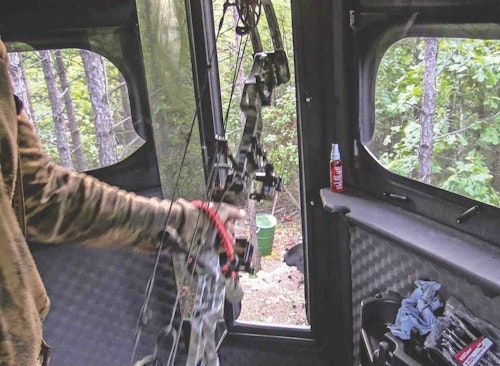
I called my dad and several close friends who were at the ready, patiently awaiting my command. Finally, I climbed from the blind and went in search of the downed bear, which I found within 60 yards of the blind. My voice shook as I exclaimed, “Holy cow, Batman,” reverently! And followed with “What a bear. What a beast. Thank you Lord!” My plan had worked. It even seemed easy, if you look at the 2018 only, discounting the last five years of hunting. The combination of the scarce mast and the Redneck Blind created the dynamics for killing the largest bodied bear of my life. On a digital scale, the big bore weighed exactly 550 pounds. The skull green scored just over 20 inches, but I suspect after drying it will be under 20 inches, barely missing the Boone and Crockett minimum.

Sidebar: Redneck Hunting Blinds
I’ve devoted the last 10 years of my hunting to understanding black bears and the best way to hunt them. People often ask for the “silver bullet,” and frankly, there aren’t many. They want to know, “What’s the best bait?” “What’s the best place to hunt?” or “What’s the best time of year?” Successful hunters do a combination of things right to find consistent success. However, I do believe I’ve found the “silver bullet” when it comes to beating a bear’s nose while hunting over bait. It’s using an enclosed, sealed blind to beat their nose. Whitetail hunters have been using the same blinds with great success.
In 2018, I put up a Redneck Buck Palace (www.redneckblinds.com) on a proven bear property in Oklahoma. The property had been known to hold big bears, but we rarely harvested them. Using just conventional scent control methods against the swirling winds of the Ouachita Mountains has never worked well for me. These blinds have rubber gaskets on the doors and windows. They aren’t truly airtight, but they’re tight enough that game just doesn’t smell you, even at close range.
We thought the bears might tear the blind up, because they’re notorious for damaging man-made items. However, I’ll report after six months of the blind being up it’s received no damage from bears. I do have pictures of them climbing the ladder and investigating the blind. I’m conscious about not leaving food in the blind. I’ve starting taking the ladder off when I leave. These blinds aren’t cheap, but neither is success. If you calculated the money I’ve spent baiting bears in the last five years, the investment in a blind is money well spent.
Hunting images by Clay Newcomb

